[Below is the next installment on the World Series of 50, 75 and 100 years ago. On Wednesday, Rita and I head to the Atlantic side of Florida, and so I’ll be switching from writing to reading. Hope to finish the biographies of two great artists, Satchel Paige and Leonardo da Vinci. After that, on to Hot Stove #63 (The 1942 Negro League World Series) and Hot Stove #64 (The 1967 World Series.)]
In 1942, with World War II underway, there was some thought that there would not be a baseball season. President Franklin Roosevelt lifted that cloud with his “Green Light” letter that encouraged baseball to continue as a recreational outlet for fans working on the war effort. This also meant there would be a 1942 World Series. Actually, two of them – one for the Major Leagues and one for the Negro Leagues.
1942 – St. Louis Cardinals v. New York Yankees: In 1926, the Cardinals beat the Yankees in the World Series. Between 1927 and 1941, the Yankees returned to the Series eight times and won all of them. In that same time period, the Cards won two and lost two. As of today, the Cards and Yankees have won more World Series than any other team: Yankees – 27; Cardinals – 11. Surprise stat: Next in line with 9 is the A’s franchise (Philadelphia/Kansas City/Oakland). Spoiler alert: none of the A’s championships were in KC (5 in Philadelphia and 4 in Oakland).
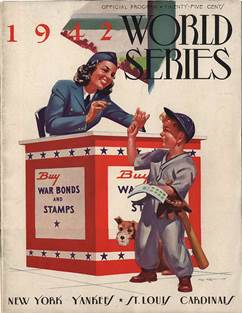
The story of the 1942 Cardinals starts with Branch Rickey. Rickey was the manager and then general manager of the Cardinals from 1919 to 1942. He pioneered the farm system in the major leagues, and his minor leaguers stocked the famed Gas House Gang in the 1930’s and the talent for three world championships in 1942, 1944 and 1946. Rickey did not stick around for the last two – he moved on to Brooklyn after the 1942 season and famously broke the color line with Jackie Robinson in 1947. Below, from 1934, Rickey with Gas House Gang players Dizzy Dean and Frankie Frisch.
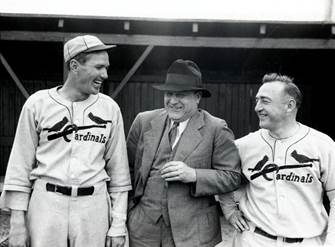
In the 1942 regular season, St. Louis was 10 games behind the Dodgers on August 5. They then went on a 43-8 run to finish at 106-48, to this day their best season ever. The pennant run was so good that one pundit said they stole everything except first base. Willard Mullin, the New York sports cartoonist who created the Brooklyn “Bums” caricature, depicted the team as “Swifty” for its riverboat gambler results. In later seasons, Mullin used variations of the top-hatted, swirling mustached dude to portray the Cardinals. The 1942 team is often referred to as the “St. Louis Swifties.”
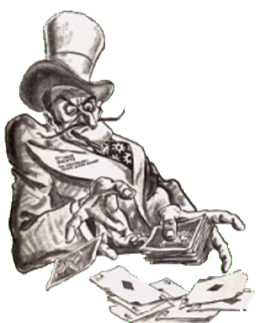
Eight men on the Cardinals roster finished in the top-20 of the MVP voting, six position players and two pitchers. Pitcher Mort Cooper was the MVP. The offense was led by Enos Slaughter, Marty Marion and Stan Musial.
1942 was Stan Musial’s first full year in the majors. He hit .315 and would become one of the best all-time players. His fellow rookie Whitey Kurowski played third base and had a vital role in the Cardinals success in the 1940’s. After a childhood accident, Kurowski had lost four inches of an infected forearm bone that left his right arm several inches shorter than his left arm. He built up his muscles, convinced coaches he could play and became a 4-time all-star. You will meet him again in Game 5.
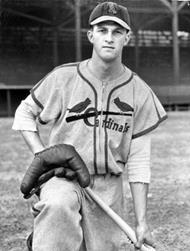
Stan Musial – 1942
The Yankees finished 103-51 and were also loaded with stars. MVP Joe Gordon and five other Yankees finished in the top-20 of MVP voting, including Joe DiMaggio, Bill Dickey and Phil Rizzuto.
In Game 1, the Yankees Red Ruffing had a no-hitter going through two outs in the 8th. That would be the high point of the Series for the Yankees. They went on to win the game, but it was their only victory.
The Cards won Game 2 by a score of 4-3 when Enos Slaughter killed a 9th inning rally by throwing out a runner at third. Game 3 was a 2-0 shutout preserved by Musial and Slaughter making homer-saving catches. The Cards then took Game 4 (9-6) to lead the Series, three games to one.
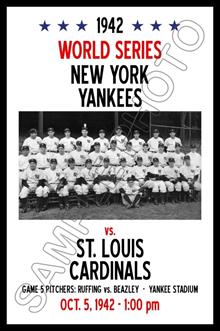
Game 5 was a pitchers’ duel between Red Ruffing of the Yankees and Johnny Beazley of the Cards. Scoring started with an early exchange of home runs by Phil Rizzuto and Enos Slaughter. Each team pushed across another run to make it a 2-2 tie going into the ninth. With one Cardinal on base, Whitey Kurowski came to the plate and hit a 2-run homer to put the Cards ahead 4-2.
The Yankees countered by starting the bottom of the ninth with a Joe Gordon hit and then an error that put men on first and second with nobody out. This is where I will pause to talk about Doc Weaver, the inspirational and eccentric trainer for the Cardinals.
Harrison “Doc” Weaver had played football for college coach Branch Rickey in 1906. Rickey brought him to the Cardinals in 1928, and Doc stayed on as trainer until he died in 1955. Here he is with Dizzy and Daffy Dean, circa 1934.

When the Cardinals were slumping in early August of 1942, Doc was given credit for loosening them up by playing musical oddities in the clubhouse, most notably “Pass the Biscuits, Mirandy” by Spike Jones. Doc also played the mandolin and held impromptu music sessions that included Stan Musial on the slide whistle and Harry Walker keeping time with coat hangers on a clubhouse chair. I’ll let this Spike Jones video give you an idea of the Cardinals clubhouse. Click here (2:50).
But Doc’s best known feature was his ability to put hexes on opposing players. If you believe in hexes. Doc’s “double whammy” has been widely reported, including by George Vecsey in his biography Stan Musial: An American Life. Musial recalled the gesture as “crossed wrists, hands back to back, then closed the second and third fingers of each hand so that the first and fourth fingers protruded like horns.” There are also reports of an inverted triple whammy.
Now back to the game. The way the story goes, Cards utility infielder Creepy Crespi was in the dugout and asked Doc Weaver to put the double whammy on Joe Gordon, the runner on second base. Weaver did so, and then…
Gerry Priddy came to the plate with the intent to bunt the two runners over to second and third. The first pitch was high and so Priddy took the pitch. Gordon wandered too far off second base in anticipation of the bunt and was picked off by catcher Walker Cooper. The double whammy worked? Whatever, the rally fizzled, and Game 5 ended with a pop-up and a groundout. The St. Louis Swifties were World Series champions.
Hall of Famers: Seven players from the MLB World Series in 1942 are enshrined at Cooperstown.
St. Louis Cardinals: Stan Musial, Enos Slaughter. New York Yankees: Joe DiMaggio, Phil Rizzuto, Joe Gordon, Bill Dickey, Red Ruffing [KC Trivia: Joe Gordon managed the A’s in 1961 and the Royals in 1969.]
Both managers in the MLB Series are also in the Hall of Fame, Billy Southworth of the Cards and Joe McCarthy of the Yankees. As is one of the umpires, Cal Hubbard.
To top it off, the national MLB radio coverage was provided by the first two announcers inducted into the broadcasting wing of the Hall of Fame, Red Barber and Mel Allen.
To further evidence the quality of baseball players in 1942, seven players from the Negro Leagues World Series are likewise enshrined. More about that in upcoming Hot Stove #63.
The War and Baseball: Given the green light by President Roosevelt, baseball played out the 1942 season with patriotic messages. Games were often used as rallies to sell war bonds. The cover and many advertisements in the World Series program echoed this theme. One of my favorites is this beer ad taking on Adolph Hitler with baseball metaphors.

Roosevelt’s green light did not exempt players from the draft. The 1942 rosters stayed mostly intact, but by the 1943 season, many players had been enlisted or were drafted. Nine players from the 1942 World Series rosters were in the service the next season, including Joe DiMaggio, Phil Rizzuto, Red Ruffing, Enos Slaughter and Johnny Beazley.
The Yankees and Cards still won their respective pennants in 1943, but this time the Yankees won the World Series. The Cards again won the NL pennant in 1944 and beat the St. Louis Browns in the “Streetcar Series.” In 1945, while Stan Musial was away in the Navy, the Cards finished three games behind the Cubs in the race for the NL pennant.
In 1946, all players were back from the war. More than 500 major leaguers had served. The Cards started slowly and fell behind the Dodgers just like they had in 1942. Doc Weaver was asked to help by bringing back “Pass the Biscuits, Mirandy.” His original copy had been broken, but after a diligent search, the clubhouse again had the nutty music.
And the Cardinals got hot and ended the season in a tie with the Dodgers. They beat the Dodgers two games to none in the first-ever pennant playoff. The Cards then beat the Red Sox in the 1946 World Series (4-3). The winning run in Game 7 came on Enos Slaughter’s famous “Mad Dash.” In the photo below, from that 1946 team: Whitey Kurowski, Enos Slaughter, Marty Marion and Stan Musial. One more Doc Weaver story: he is given credit for extending the careers of Marion (bad back) and Kurowski (bad arm) by applying his “magic hands” to their disabilities.
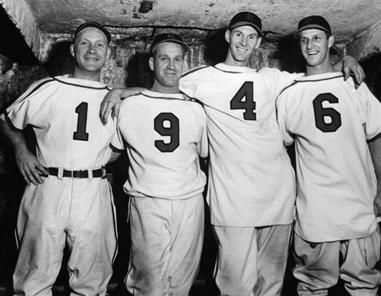
After the Cardinals won the 1946 pennant, they did not win another for 17 years. In that same time period, the Yankees won 14 pennants and 10 World Series. In 1964, the Cardinals were back in the World Series, playing…the Yankees. The Cards won the Series, but then strangely lost their manager Johnny Keane who moved over to the Yankees to replace the fired Yogi Berra.
Lonnie’s Jukebox: No, I do not remember any 1942 music. I was a year old. But the mention of Spike Jones being played in the Cardinals clubhouse brought back a childhood memory – the zany “Cocktails for Two” by Spike Jones and his City Slickers. It starts out seriously, but soon changes to Spike’s unique style. Please join the over one million viewers of this video. Click here (2:44).

Movie notes: Four of our favorites from Telluride are now in theatres or soon will be: Loving Vincent, Lady Bird, The Shape of Water and Darkest Hour. We also just saw Three Billboards Outside Ebbing, Missouri – liked it a lot. Waiting anxiously for The Post.